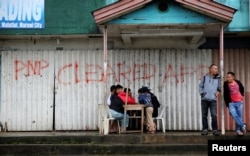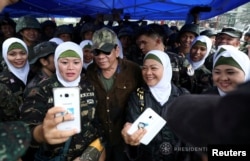The slaying this week of two key Muslim rebel leaders during a prolonged fight with troops in the Philippines will help the country lift martial law over the island of Mindanao unless new violence flares, experts say.
Philippine President Rodrigo Duterte declared martial law over the island in May to help troops and police raise efficiency in fighting the Maute Group of Muslim rebels in one island city. The president’s office said Monday troops in Marawi had killed a founding brother of the group along with a leader in Abu Sayyaf, a Philippine kidnapping outfit backed by Islamic State (ISIS). Abu Sayyaf was apparently helping the Maute Group.
Martial law could be lifted as scheduled Dec. 31, if not sooner, some analysts say. But the government has not committed to an end date as it fights remaining rebels in the embattled city. If new rebel violence surfaces in Marawi or elsewhere in historically violent Mindanao, home to 21 million people, the order could be extended.
Muslim rebel violence in the past 50 years has left 120,000 people dead.
Martial law in Mindanao
“Perhaps the best indication of the level of concern by the Philippine government regarding the resilience of the Abu Sayyaf group in the aftermath of the Marawi standoff will be found in the narrative surrounding the decision to lift martial law in Mindanao,” said Carl Baker, director of programs with the think tank Pacific Forum CSIS in Honolulu.
A lifting of martial law would calm skeptics who fear Duterte wants to extend that order throughout the Philippines as a way to fight crime, especially the illegal drug trade. Some worry about a return to 1972, when authoritarian former president Ferdinand Marcos declared martial law nationwide to put down civil unrest.
Last month thousands gathered in Metro Manila to protest martial law as well as the suspected extrajudicial killings of drug sellers. Duterte has said he would expand martial law nationwide if protesters threaten public order, according to Philippine media outlets.
Defense officials will evaluate progress in Marawi in light of the two killings to reconsider martial law, Defense Secretary Delfin Lorenzana said. In July, lawmakers supported extending martial law in Mindanao through year’s end.
“We are going to assess the situation in Mindanao, and then we will make our recommendation to the president in due time,” Lorenzana told a news conference in Manila.
The Mindanao-based news website Davaotoday.com reported in June that the military had set up about 17,500 checkpoints on the island, set curfews in 129 population centers and positioned more than 9,700 people to patrol public spaces. Military officials have been quoted as saying martial law helped keep battles from spreading outside Marawi.
Martial law has had little effect on common people since May besides the annoyances of road checkpoints, said Rhona Canoy, president of an international school and part of a political family in the Mindanao city Cagayan de Oro.
End to the fighting
The slaying of the two Muslim insurgency leaders augurs a quick end to the fighting, the presidential office website says. Battles since the May 23 outbreak have killed more than 700 people while forcing most inhabitants to flee, often to refugee camps.
But locals in Mindanao worry the insurgency will just pick new leaders and resume fighting, Canoy said.
“There’s lots of things at are grey areas right now,” she said. “I know the government is claiming this as a victory. For the most part it is, but I keep telling everybody it’s not time to shoot off the fireworks yet.”
If troops cannot bring down the remaining rebels in Marawi or if rebuilding the city meets obstacles, Duterte might consider extending martial law again, said Miriam Coronel-Ferrer, a University of the Philippines political science professor.
“They said there are still several elements whom they are calling on to surrender and then they will move toward the rehab, so maybe they still need that kind of cover,” said Coronel-Ferrer, also a peace negotiator under the past Philippine president.
Government forces in Mindanao still face another 20 rebel groups, including one that has clashed with police and with a rival insurgency since June in the province of Maguindanao. Most groups advocate more autonomy for Muslims, who settled parts of the island and adjacent Sulu Sea about 500 years ago, but believe the Philippines’ Catholic majority controls the resources.
Islamic State had also supported the slain Abu Sayyaf leader, Isnilon Hapilon, analysts believe, and the Middle Eastern terrorist group may now be looking for someone else to spread its influence in the Philippines.
About 40 foreign fighters, some from the Middle East, have helped the Maute Group partly in the name of ISIS, said Bibhu Routray, a visiting scholar in Security, Terrorism and Counter-Terrorism Studies at Murdoch University in Australia. With Hapilon dead, ISIS now expects a 39-year-old Malaysian who’s still helping the Maute Group in Marawi to lead operations there, unless he has been killed, Routray said.
“Possibly there will be a vacuum and someone will have to fill it up as this process of rebuilding the organization,” he said.















